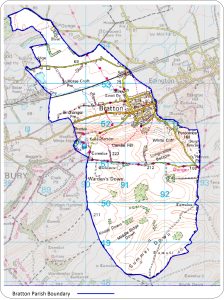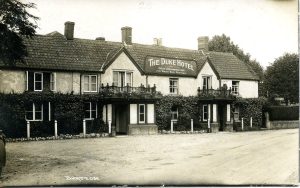Bratton Village
Bratton is a large, picturesque village in Wiltshire, England, east of Westbury on the north edge of Salisbury Plain. Located three miles from the town of Westbury (mainline train to London), twenty miles from the Roman City of Bath and twenty miles from the historical city of Salisbury.
Bratton is home to over 1250 residents and has a thriving community of clubs, societies and social groups.
Bratton Parish

The Parish of Bratton extends over 15 square kilometres – 7 kilometres from north to south and about 3 kilometres from east to west. The main settlement area of Brattton Village is about 1 square kilometre.
The chalk escarpment of Salisbury Plain marks the southern boundary of the village. The eastern boundary of the parish is determined by the course of the stream known in the Middle Ages as the Milbourne and later as the Stradbrook, which is fed by the Luccombe and Church Springs. Agricultural land marks northern and western boundaries.

Village Centre
In the centre of the village is The Duke public house, convenience store and Post Office, Bratton Community Primary School, the Village Green including a young children’s play park, a Doctor’s Surgery, along with three halls (Jubilee Hall, Pavilion and the Church Institute) all regularly used for activities, fundraising events as well as talks and private functions.
Notable buildings in the village are St James’s Church, Bratton House, Bratton Baptist Chapel and a fine 17th century Court House, which is probably of medieval origin.

Despite local folklore linking it to the notorious Judge Jeffreys and his ‘Bloody Assize’ of 1685, it was not a law court but was the meeting place for the main manor court in Bratton. Parts of Bratton came under the jurisdiction of several manors. From the 1660s, the largest and most well known of these was the Thynne family of Longleat, who were later given the title Viscount Weymouth and later still, Marquis of Bath. It was their tenants who attended meetings at Bratton Court House.

The Westbury White Horse and the earthworks of Bratton Castle Iron Age hill fort are both in Bratton parish.
There are a wide range of facilities and services in the village. The Duke public House, (dating from the early-19th century) includes a popular restaurant. There is a food shop, Central Stores, dating from 1906 and extended in 2002, which includes a bakery and Post Office.

Bratton Surgery is an outpost of Westbury’s White Horse Health Centre, offering consultation, basic nursing and a dispensary. Technically in Edington but generally considered to be in Bratton, Fitzroy Farm contains a popular coffee shop, a hairdresser and Bratton Plant Centre. A number of small companies and sole-traders are run from private homes in the village.
Bratton benefits from two village halls. The Jubilee Hall (1887 and extended in 1987 and 2002) is the home of the Jubilee Players amateur dramatic group, regular fitness and community classes and is also available to hire for individual events. The Church Institute is the home of Bratton Silver Band and several other village organisations, many for children. The land for the Recreation Ground (beside Trowbridge Road) was donated in memory of Horace Seymour in 1998 and offers a cricket pitch, two football pitches and a trim trail as well as a large pavilion. The village also has an Anglican and a Baptist Church, the Primary school and a recently established Pre-school.
There is a single bus service with regular services to Devizes and Westbury during the day. The NDP questionnaire indicated relatively low use of these services, with more reliance placed on private cars. The 2011 census data identified significant car ownership with 290 households having two or more cars.


